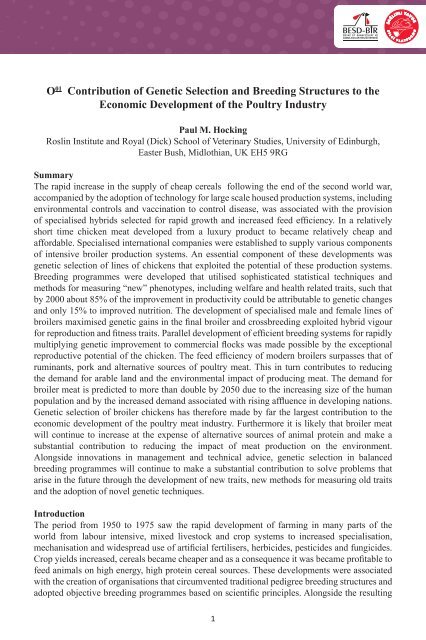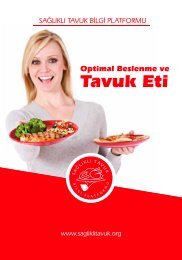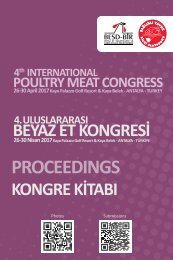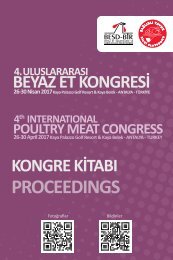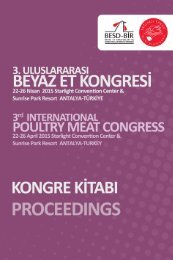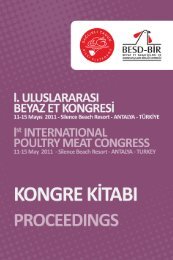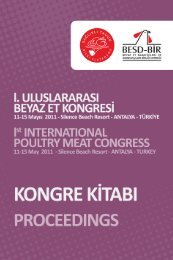3rd International Poultry Meat Congress
Proceedings
Proceedings
You also want an ePaper? Increase the reach of your titles
YUMPU automatically turns print PDFs into web optimized ePapers that Google loves.
O 01 Contribution of Genetic Selection and Breeding Structures to the<br />
Economic Development of the <strong>Poultry</strong> Industry<br />
Paul M. Hocking<br />
Roslin Institute and Royal (Dick) School of Veterinary Studies, University of Edinburgh,<br />
Easter Bush, Midlothian, UK EH5 9RG<br />
Summary<br />
The rapid increase in the supply of cheap cereals following the end of the second world war,<br />
accompanied by the adoption of technology for large scale housed production systems, including<br />
environmental controls and vaccination to control disease, was associated with the provision<br />
of specialised hybrids selected for rapid growth and increased feed efficiency. In a relatively<br />
short time chicken meat developed from a luxury product to became relatively cheap and<br />
affordable. Specialised international companies were established to supply various components<br />
of intensive broiler production systems. An essential component of these developments was<br />
genetic selection of lines of chickens that exploited the potential of these production systems.<br />
Breeding programmes were developed that utilised sophisticated statistical techniques and<br />
methods for measuring “new” phenotypes, including welfare and health related traits, such that<br />
by 2000 about 85% of the improvement in productivity could be attributable to genetic changes<br />
and only 15% to improved nutrition. The development of specialised male and female lines of<br />
broilers maximised genetic gains in the final broiler and crossbreeding exploited hybrid vigour<br />
for reproduction and fitness traits. Parallel development of efficient breeding systems for rapidly<br />
multiplying genetic improvement to commercial flocks was made possible by the exceptional<br />
reproductive potential of the chicken. The feed efficiency of modern broilers surpasses that of<br />
ruminants, pork and alternative sources of poultry meat. This in turn contributes to reducing<br />
the demand for arable land and the environmental impact of producing meat. The demand for<br />
broiler meat is predicted to more than double by 2050 due to the increasing size of the human<br />
population and by the increased demand associated with rising affluence in developing nations.<br />
Genetic selection of broiler chickens has therefore made by far the largest contribution to the<br />
economic development of the poultry meat industry. Furthermore it is likely that broiler meat<br />
will continue to increase at the expense of alternative sources of animal protein and make a<br />
substantial contribution to reducing the impact of meat production on the environment.<br />
Alongside innovations in management and technical advice, genetic selection in balanced<br />
breeding programmes will continue to make a substantial contribution to solve problems that<br />
arise in the future through the development of new traits, new methods for measuring old traits<br />
and the adoption of novel genetic techniques.<br />
Introduction<br />
The period from 1950 to 1975 saw the rapid development of farming in many parts of the<br />
world from labour intensive, mixed livestock and crop systems to increased specialisation,<br />
mechanisation and widespread use of artificial fertilisers, herbicides, pesticides and fungicides.<br />
Crop yields increased, cereals became cheaper and as a consequence it was became profitable to<br />
feed animals on high energy, high protein cereal sources. These developments were associated<br />
with the creation of organisations that circumvented traditional pedigree breeding structures and<br />
adopted objective breeding programmes based on scientific principles. Alongside the resulting<br />
1


